Tetracontagon
| Regular tetracontagon | |
|---|---|
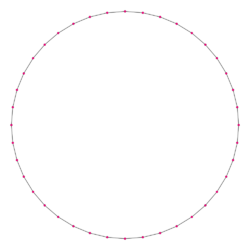 A regular tetracontagon | |
| Type | Regular polygon |
| Edges and vertices | 40 |
| Schläfli symbol | {40}, t{20}, tt{10}, ttt{5} |
| Coxeter diagram | |
| Symmetry group | Dihedral (D40), order 2×40 |
| Internal angle (degrees) | 171° |
| Dual polygon | Self |
| Properties | Convex, cyclic, equilateral, isogonal, isotoxal |
In geometry, a tetracontagon or tessaracontagon is a forty-sided polygon or 40-gon.[1][2] The sum of any tetracontagon's interior angles is 6840 degrees.
Regular tetracontagon
A regular tetracontagon is represented by Schlafli symbol {40} and can also be constructed as a truncated icosagon, t{20}, which alternates 2 types of edges. Furthermore, it can also be constructed as a twice-truncated decagon, tt{10}, or a thrice-truncated pentagon, ttt{5}.
One interior angle in a regular tetracontagon is 171°, meaning that one exterior angle would be 9°.
The area of a regular tetracontagon is (with t = edge length)
and its inradius is
The factor is a root of the octic equation .
The circumradius of a regular tetracontagon is
As 40 = 23 × 5, a regular tetracontagon is constructible using a compass and straightedge.[3] As a truncated icosagon, it can be constructed by an edge-bisection of a regular icosagon. This means that the values of and may be expressed in radicals as follows:
Construction of a regular tetracontagon
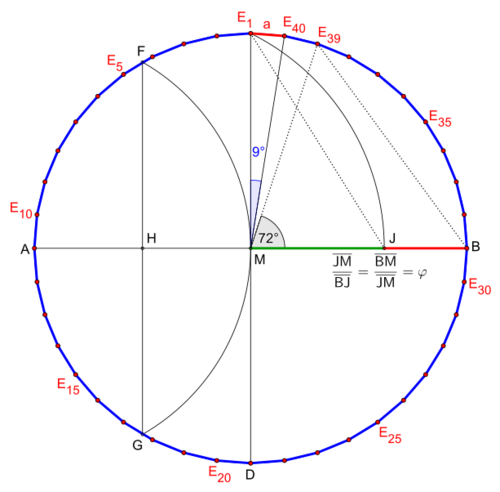
Circumcircle is given
- Construct first the side length JE1 of a pentagon.
- Transfer this on the circumcircle, there arises the intersection E39.
- Connect the point E39 with the central point M, there arises the angle E39ME1 with 72°.
- Halve the angle E39ME1, there arise the intersection E40 and the angle E40ME1 with 9°.
- Connect the point E1 with the point E40, there arises the first side length a of the tetracontagon.
- Finally you transfer the segment E1E40 (side length a) repeatedly counterclockwise on the circumcircle until arises a regular tetracontagon.
The golden ratio
Side length is given

(The construction is very similar to that of icosagon with given side length)
- Draw a segment E40E1 whose length is the given side length a of the tetracontagon.
- Extend the segment E40E1 by more than two times.
- Draw each a circular arc about the points E1 and E40, there arise the intersections A and B.
- Draw a vertical straight line from point B through point A.
- Draw a parallel line too the segment AB from the point E1 to the circular arc, there arises the intersection D.
- Draw a circle arc about the point C with the radius CD till to the extension of the side length, there arises the intersection F.
- Draw a circle arc about the point E40 with the radius E40F till to the vertical straight line, there arises the intersection G and the angle E40GE1 with 36°.
- Draw a circle arc about the point G with radius E40G till to the vertical straight line, there arises the intersection H and the angle E40HE1 with 18°.
- Draw a circle arc about the point H with radius E40H till to the vertical straight line, there arises the central point M of the circumcircle and the angle E40ME1 with 9°.
- Draw around the central point M with radius E40M the circumcircle of the tetracontagon.
- Finally transfer the segment E40E1 (side length a) repeatedly counterclockwise on the circumcircle until to arises a regular tetracontagon.
The golden ratio
Symmetry

The regular tetracontagon has Dih40 dihedral symmetry, order 80, represented by 40 lines of reflection. Dih40 has 7 dihedral subgroups: (Dih20, Dih10, Dih5), and (Dih8, Dih4, Dih2, Dih1). It also has eight more cyclic symmetries as subgroups: (Z40, Z20, Z10, Z5), and (Z8, Z4, Z2, Z1), with Zn representing π/n radian rotational symmetry.
John Conway labels these lower symmetries with a letter and order of the symmetry follows the letter.[4] He gives d (diagonal) with mirror lines through vertices, p with mirror lines through edges (perpendicular), i with mirror lines through both vertices and edges, and g for rotational symmetry. a1 labels no symmetry.
These lower symmetries allows degrees of freedoms in defining irregular tetracontagons. Only the g40 subgroup has no degrees of freedom but can seen as directed edges.
Dissection
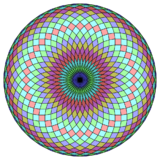 regular |
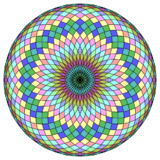 Isotoxal |
Coxeter states that every zonogon (a 2m-gon whose opposite sides are parallel and of equal length) can be dissected into m(m-1)/2 parallelograms. These tilings are contained as subsets of vertices, edges and faces in orthogonal projections m-cubes[5] In particular this is true for regular polygons with evenly many sides, in which case the parallelograms are all rhombi. For the regular tetracontagon, m=20, and it can be divided into 190: 10 squares and 9 sets of 20 rhombs. This decomposition is based on a Petrie polygon projection of a 20-cube.

|

|
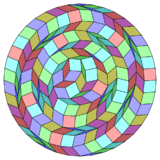
|
Tetracontagram
A tetracontagram is a 40-sided star polygon. There are seven regular forms given by Schläfli symbols {40/3}, {40/7}, {40/9}, {40/11}, {40/13}, {40/17}, and {40/19}, and 12 compound star figures with the same vertex configuration.
| Picture |  {40/3} |
 {40/7} |
 {40/9} |
 {40/11} |
 {40/13} |
 {40/17} |
 {40/19} |
|---|---|---|---|---|---|---|---|
| Interior angle | 153° | 117° | 99° | 81° | 63° | 27° | 9° |
Many isogonal tetracontagrams can also be constructed as deeper truncations of the regular icosagon {20} and icosagrams {20/3}, {20/7}, and {20/9}. These also create four quasitruncations: t{20/11}={40/11}, t{20/13}={40/13}, t{20/17}={40/17}, and t{20/19}={40/19}. Some of the isogonal tetracontagrams are depicted below, as a truncation sequence with endpoints t{20}={40} and t{20/19}={40/19}.[6]
 t{20}={40} |
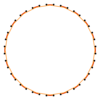
|

|
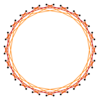
|
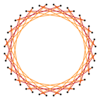
|
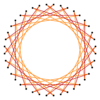
|
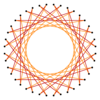
|
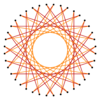
|

|
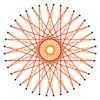
|
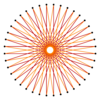 t{20/19}={40/19} |
References
- ↑ Gorini, Catherine A. (2009), The Facts on File Geometry Handbook, Infobase Publishing, p. 165, ISBN 9781438109572, https://books.google.com/books?id=PlYCcvgLJxYC&pg=PA165.
- ↑ The New Elements of Mathematics: Algebra and Geometry by Charles Sanders Peirce (1976), p.298
- ↑ Constructible Polygon
- ↑ The Symmetries of Things, Chapter 20
- ↑ Coxeter, Mathematical recreations and Essays, Thirteenth edition, p.141
- ↑ The Lighter Side of Mathematics: Proceedings of the Eugène Strens Memorial Conference on Recreational Mathematics and its History, (1994), Metamorphoses of polygons, Branko Grünbaum
External links
- Weisstein, Eric W.. "Tetracontagon". http://mathworld.wolfram.com/Tetracontagon.html.
- Naming Polygons and Polyhedra
- tessaracontagon













